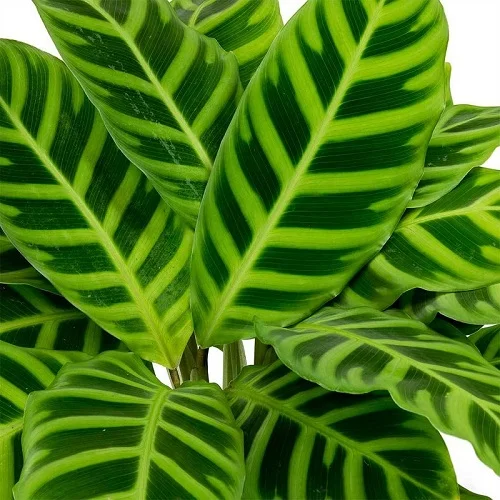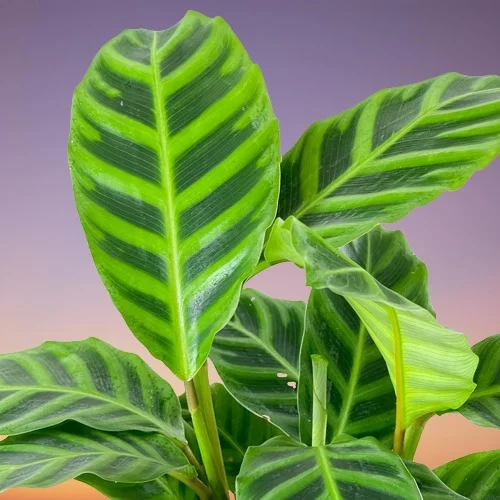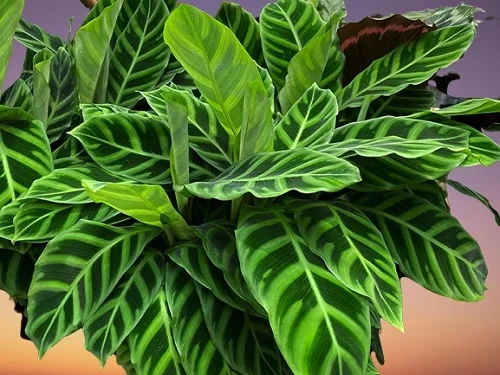Calathea zebrina (Goeppertia zebrina) Indoor Care, Common Problems & Remedies
Some links in this post may be affiliate links
Calathea zebrina (Goeppertia zebrina) thrives in bright indirect light, warm and humid conditions and consistently moist, rich, well-drained soil coupled with monthly feeding in the growing season.
Calathea zebrina commonly called Zebra Calathea or Calathea Zebra Plant is one of the popular Calathea varieties. It bears large, ovate leaves which are dark-green above and reddish-purple below while the spines, veins and margins are a lime-green color.
The species name, 'zebrina', is in reference to the zebra-like stripes appearance of the leaves and places these plants among the best plants for the living room where they will create a great first impression.

Botanical name: Goeppertia zebrina
Synonym: Calathea zebrina
Family: Marantaceae
Common name: Zebra Calathea, Calathea Zebra Plant
Origin
Calathea zebrina also called Goeppertia zebrina is native to the tropical forests in southeastern Brazil where it grows on the forest floors and is among the best tropical foliage plants that you can grow in the home or office space.
Size
Goeppertia zebrina grows in clumps to a height of about 2-3 feet. The leaves are about 1-2 feet long.
Is Calathea zebrina poisonous?
No. Calathea zebrina is non-toxic to both humans and pets as indicated by ASPCA. It is safe for cats, dogs and other pets in the home.
Related Plants
Goeppertia zebrina is closely related to the Marantas, Ctenanthe and Stromanthe which are collectively called Prayer Plants in reference to their curious characteristic of closing their leaves at night.
Where to Buy
Are you are looking to add the Calathea zebrina to your collection? You may acquire them from Amazon (Link to Amazon).
How to care for Calathea zebrina indoors
To care for Calathea zebrina indoors, give it bright indirect light, average warmth of 15-260C, humidity of 50-60% and consistently moist, fertile, well-drained soil coupled with monthly feeding during the growing season.
Goeppertia zebrina care only requires repotting when it becomes pot-bound. Pruning is necessary to keep it neat and also minimize pest and disease infestations. Keep reading for more on the growing conditions and how to achieve them.

Light Requirements
Does Calathea zebrina need sunlight?
No. Calathea zebrina grows best in bright indirect light away from direct sunlight to prevent scorching of the leaves. Keep it away from too bright light as it will cause the leaf colour to fade.
Where the natural lighting is not sufficient, instal a full spectrum grow light to prevent yellowing and stunted growth.
Turn the pot every so often to ensure that the plant receives light on all sides for even growth and prevent unbalanced growth.
Watering
How often should I water Calathea zebrina?
Water Calathea zebrina liberally in spring and summer and allow the top 1-2 inches of soil to dry out between waterings. Keep the soil consistently moist but not soggy to prevent rotting, yellowing and drooping.
Decrease watering in fall and winter as growth is minimal at this time but do not allow the soil to dry out completely to avoid drooping and curling leaves.
Use water that is at room temperature to avoid cold shock which can lead to stunted growth and plant death. The water should be free of chlorine and flourides which will cause brown leaf tips and edges.
Confirm that the pot has a drainage hole and the soil is well-draing to prevent waterlogging which can result in root-rot and death of the plant.
To minimize fungal infestations, avoid wetting the foliage during watering or water from the bottom instead.
Temperature & Humidity
Goeppertia zebrina prefers an average warmth of 15-260C. Keep it away from drafts as they cause sudden changes in temperature which cause reduced growth, drooping and eventual death of the plant.
Calathea zebrina requires a humidity of 50% to 60% to thrive as a low humidity will result in brown leaf tips and edges. To raise humidity, set the pot on a wet pebble tray, use a humidifier or group the plants together.
You may also grow the plant in a closed terrarium or a well-lit bathroom, kitchen and other moist areas in the home. Do not mist the leaves as it can lead to fungal diseases. Maintain good ventilation to discourage fungal diseases.
Fertilizer
What is the best fertilizer for Calathea zebrina?
Feed Calathea zebrina with a balanced, liquid fertilizer every 4 weeks in spring and summer for a lush growth.
Withhold feeding in fall and winter as growth is reduced and feeding at this time can lead to fertilizer burn; brown leaf tips and edges.
Once in a while, flush out accumulated salts from the soil by running a stream of water through the soil. Allow the stream of water to run for some time and repeat the process several times.
Potting Soil
What kind of soil does Calathea zebrina like?
Calathea zebrina likes a rich, loose, free-draining soil which does not get soggy. Most potting mixes designed for Aroids are perfect for these plants.
Repotting
Repot Goeppertia zebrina every 2-3 years at the beginning of the growing season (spring to early summer), when it gets root-bound. Take care not to injure its delicate roots.
Use a pot one size larger that has a drainage hole and well-draining soil to prevent rotting and death of the plant. Check out these pots with drainage hole on Amazon.
Water the plant thoroughly at least 1 day before repotting to make it easier and also hasten establishment; a well hydrated plant suffers less repotting shock and takes a shorter time to take root.
You may divide a large plant that has outgrown its current pot into several sections and use the splits to propagate new plants.
Repotting may cause the leaves to droop but the plant will eventually recover once it has taken root; in about 3-4 weeks.
Pruning & Grooming
Pruning Calathea zebrina is easy. Remove dead and yellow foliage to maintain the plant neat and also minimize pest and disease infestations. Cut the leaves with a sharp knife or clean pair of pruning scissors at the base, where the leaf meets the stalk.
Occasionally clean the leaves by damp-wiping with a soft cloth to get rid of dust and reduce pest and disease infestations.
Calathea zebrina Propagation
Calathea zebrina is propagated by plant division at the beginning of the growing season (springto early summer). Dividing the plant at this time hastens establishment as it is in the active growth phase. Unfortunately, Goeppertia zebrina will not propagate from leaf or stem cuttings.
Learn how to propagate Calathea zebrina (Goeppertia zebrina).

Calathea zebrina Problems & Solutions
Calathea zebrina (Goeppertia zebrina) problems are yellow leaves, curling leaves, brown leaf tips and edges, drooping leaves, plant dying, pests and diseases among others. Keep reading for more on these problems and how to fix them.
Yellow leaves
The main causes of yellow leaves on Calathea zebrina are inconsistent watering, soggy soil, extreme temperatures, lack of nutrients or too little light.
How to fix it
Inconsistent watering: Water when the top 1-2 inches of soil dry out but never allow the soil ball to dry out completely.
Soggy soil: Use a pot with a drainage hole and well-draining soil. Always discard excess water from the saucer after watering.
Extreme temperatures: Keep the plant away from drafts coming from AC units, heat sources, windy doors, drafty windows, hot air vents among others.
Lack of nutrients: Fertilize the plant with a balanced, liquid fertilizer every 4 weeks in spring and summer.
Too little light: Place the plant where it will receive bright indirect light or use a grow light if the natural lighting is not enough.
Curling leaves
Curling leaves on Calathea zebrina are caused by inconsistent watering, soggy soil, drafts, dry air, being pot-bound.
How to fix it
Inconsistent watering: Water when the top 1-2 inches of soil feel dry but never allow the soil ball to dry out completely. Do not water on a schedule.
Soggy soil: Use a pot with a drainage hole and well-draining soil.
Drafts: Keep the plant away from drafts coming from AC units, heat sources, windy doors, drafty windows, hot air vents among others.
Dry air: To upscale humidity, set the pot on a wet pebble tray or use a humidifier.
Being pot-bound: Repot the plant into a pot one size larger when you spot roots growing through the drainage hole or divide it into several sections to propagate new plants.
Brown leaf tips and edges
Brown leaf tips and edges on Calathea zebrina are caused by dry air, pests infestations, use of hard water or salts buildup.
How to fix it
Dry air: To elevate humidity, set the pot on a wet pebble tray or grow the plant in a well-lit bathroom, kitchen area, laundry area and other moist areas in the home.
Pests infestation: Remove the dead growth and raise humidity to discourage the pest infestations.
Use of hard water: Water the plant with rain water or filtered water.
Salts buildup: Regularly, flush out accumulated salts by running a stream of water through the soil until it comes out through the drainage hole.
Drooping leaves
Drooping leaves on Calathea zebrina are caused by dry air, improper watering, being pot-bound, pests infestations or temperature stress.
How to fix it
Dry air: To heighten humidity, set the pot on a wet pebble tray, use a humidifier or grow the plant in a closed terrarium.
Incorrect watering: Do not water on a schedule. Water when the 1-2 few inches of soil feel dry but do not allow the soil to dry out completely.
Soggy soil: Make sure that the soil is free-draining and the pot has a drainage hole.
Being pot-bound: Repot the plant into a pot one size larger than the current one or divide it into several sections to propagate new plants.
Pests infestations: Regularly check betwwen and underneath the leaves for pests and carry out timely corrective measures.
Temperature stress: Keep the plant away from drafts emanating from hot air vents, stoves, AC units, wicy doors and windows among others.
Check out these 10 Causes of Calathea Drooping Leaves and How to Revive It
Plant dying
Goeppertia zebrina due to inconsistent watering, temperature stress, nutrients deficiency, low humidity, pests infestations or root-rot.
How to fix it
Inconsistent watering Water when the top 1-2 inches of soil feel dry but do not allow the soil to dry out completely. Do not water on a schedule.
Temperature stress: Keep the plant away from drafts emanating from AC units, heat sources, windy doors, drafty windows, hot stoves among others.
Nutrients defeciency: Fertilize with a balanced, liquid fertilizer every 4 weeks in spring and summer.
Low humidity: To increase humidity, set the pot on a wet pebble tray or use a humidifier.
Pests infestations: Regularly inspect the plant for pests and carry out timely control measures.
Root-rot: The disease is prevalent in soggy soil.
- Carefully slip the plant out of its pot and inspect the roots.
- Trim the brown-black, mushy roots and treat the healthy roots with a copper-based fungicidal solution as indicated on the label.
- Disinfect the pot with the fungicidal solution or use a fresh pot to repot the plant in fresh, well-draining soil.
- Do not water the plant immediately and keep it dry for 5-7 days before you can resume watering.
- Use a pot with a drainage hole and well-draining soil to prevent the soil from getting soggy.
- Lessen watering in fall and winter as growth is slowed at this time; keep the soil slightly moist.
Take a look at these 12 Reasons Why Calathea is Dying and How to Save It.
Pests
Common pests on Calathea zebrina are mealybugs, aphids, scale insects and spidermites.
How to fix it
- Isolate the affected plant to prevent spread to the rest of the plants.
- Treat the infested plant with neem oil or insecticidal soap as per the manufacturers' recommendations.
- Regularly check underneath and between the leaves for these pests and carry out timely control measures.
- Maintain the plant well pruned and raise humidity to discourage pest infestation.
Diseases
Goeppertia zebrina is prone to leaf spot disease which is common in humid conditions. The disease is indicated by brown patches surrounded by a yellow halo (brown, soft leaf spots).
How to fix it
- Remove and destroy the affected parts to minimize spread to the rest of the plants.
- Spray the affected plant with a systemic fungicide and ensure to follow the manufacturers instructions.
- Keep the plant dry for some time before resuming watering and ensure there is good air flow.
- Use a pot with a drainage hole and well-draining soil.
You liked it? Share on social media.
Related Content
Amazon Associates Disclosure
Homeplantsguide.com is a participant in the Amazon Services LLC Associates Program, an affiliate advertising program designed to provide a means for sites to earn advertising fees by advertising and linking to amazon.com.





